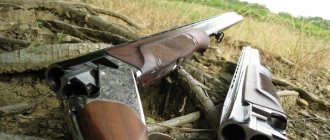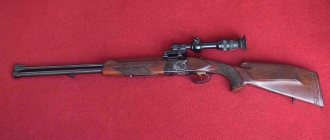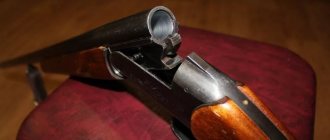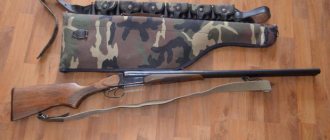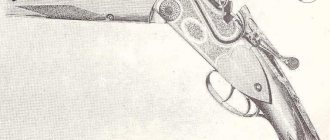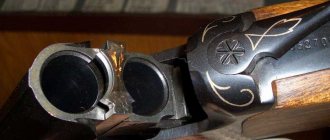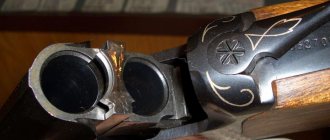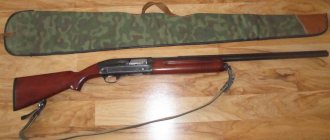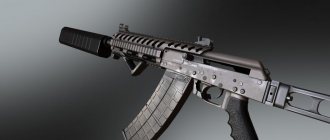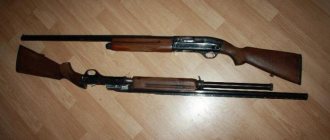Optical sight and zeroing
Toz-34 hunting rifle: description, characteristics, photos
It is difficult to imagine hunting with small guns without the use of an optical sight. It is best to choose an optic with variable magnification (from 3x to 6x) so that you can always adjust the image depending on the distance from the shooter to the target. Also, before hunting, it is necessary to properly zero the rifle, using bullets with a rounded tip (they leave smoother marks on the target) and following the following instructions:
- Choosing a shooting position. It would be best to go to a shooting range where air humidity and wind speed will not affect the bullet. But if this is not possible, you should wait for a windless day and find an open field where there are no people or uneven terrain that would interfere with shooting.
- We are building a shooting bench. Not everyone has a locking machine, so that the rifle does not twitch while aiming; it can be equipped with a bipod or simply install several sandbags. Also, nothing should prevent the shooter from taking the most comfortable position for shooting.
- We make three test shots from a distance of 10 meters. It is best to choose the lower part of the shooting range target circle as the aiming point. The shooter's task is to ensure that the bullets land as close to each other as possible. If the analysis is more than 1 centimeter, then it is worth taking a more comfortable position or inspecting the barrel channel for defects.
- We adjust the optics and fire 3 more shots. The side drum is used to adjust the horizontal position of the lenses, and the top drum is used to adjust the vertical position. Each click of the device indicates that the lens has been moved 0.1 millimeters. It is not recommended to try to adjust the vertical and horizontal at the same time.
- We increase the distance to the target and repeat the procedure. Immediately setting a distance of 50 meters and zeroing the optics is not the best idea, since sometimes it may not be clear in which case the deviation is caused by the incorrect position of the lenses, and in which case the shooter simply jerked his hand. So you should increase the distance gradually - by 10-15 meters at a time.
As soon as you achieve ideal results while zeroing at a distance of 100 meters (no more than 3 cm of spread), the procedure can be considered complete. Further adjustment of the optics will be ineffective, since the small-caliber bullet begins to gradually lose height.
Story
Development of the TOZ-57 began in connection with the growing popularity of clay pigeon shooting in the USSR in the 1970s. The gun was developed at the Tula Arms Plant in the second half of the 1970s based on the design of the TOZ-34 gun, taking into account the experience gained during the creation and operation of the TOZ-55 Zubr guns.
In 1977, TOZ-57 was awarded the gold medal of the Leipzig Fair. In addition, TOZ-57 shotguns were awarded the USSR State Quality Mark.
In July 1978, pre-production samples of TOZ-57K and TOZ-57K-1S were presented.
After testing of the first samples was completed, in January 1979, the TOZ-57K and TOZ-57T guns were presented at the exhibition of achievements of the national economy of the USSR in Moscow and their production began in several modifications.
In April 1987, a decision was made to begin production of the TOZ-84 double-barreled hunting rifle, which was to become the new basic model of the Tula Arms Plant and replace in production the TOZ-34 hunting rifle, the TOZ-55 Zubr rifle and the TOZ-57 sporting rifle . Subsequently, production of TOZ-57 was discontinued.
Cabin of KamAZ-55102 dump truck
Hunting rifle IZH-43: reviews, photos with descriptions and technical characteristics
The KamAZ-55102 agricultural dump trucks were equipped with a standard KamAZ unified cab - all-metal, built in a cabover configuration, without a berth. It is located directly above the engine and is designed for two people. When carrying out maintenance or repair of the power unit, the cabin tilts forward. A heating system is installed inside. To improve the driver's working conditions, the KamAZ-55102 truck cab is equipped with a sprung suspension and interior upholstery that reduces noise and vibration inside the cabin.
But a forced ventilation system was not provided in the KamAZ-55102 cabin - the interior is ventilated by natural ventilation, through opening windows, vents and a sunroof. The interior heating system is water-based, powered by the engine cooling system. In subsequent years of production (second half of the 90s), the cabin was modernized: all optics were moved to the massive front bumper; and the roof began to be located noticeably higher.
Characteristics of IZH 57
Pump-action hunting shotgun: review, technical specifications, photos
The IZH-57 shotgun consists of three main parts: twin barrels, a forend and a butt. The trunks have a horizontal layout. The locking mechanism is very reliable: there are two hooks on the bottom and a locking bar on top. The trigger mechanism is internal, with an automatic safety, which blocks both the strikers and the sear, meaning it is impossible to press the triggers.
The barrel channels are chrome-plated, have choke constrictions: right - choke, left - choke
The chamber is designed for any type of cartridge case: be it paper, or plastic, or brass. At the same time, the gun is undemanding to the quality of the cartridge itself: it absorbs both factory and homemade cartridges equally well. The gun has good action, accuracy and decent accuracy regardless of the charge, that is, it shows high performance when shooting both shot and buckshot and bullets.
Options and modifications
- TOZ-57
- sporting and hunting rifle with barrels 711 mm long - TOZ-57K
is a sports shotgun for shooting on a round stand for mass sports organizations, equipped with 675 mm barrels and a trigger with two triggers - TOZ-57K-1S
- a sports shotgun for shooting on a round stand (version TOZ-57K, equipped with a trigger with one trigger) - TOZ-57T
is a sports shotgun for trench shooting for mass sports organizations, equipped with 750 mm barrels and a trigger with two triggers - TOZ-57T-1S
- a sports gun for shooting on a trench stand (version TOZ-57T, equipped with a trigger with one trigger) - TOZ-57T-12E
is a sports shotgun for participation in international competitions, a version of TOZ-57T with higher technical parameters. It has a quick-change trigger mechanism and side rails with slots (which ensures better ventilation of the barrels during prolonged intense shooting)
Shooting
To fire a shot from a TOZ-106 gun, the caliber of which is 20 mm, you need to open the bolt, move the handle to the rear position to get rid of the cartridge case, and fire the next cartridge by moving the bolt in reverse. After this, the weapon is considered ready to fire.
At the end of shooting, you must cock the hammer, turn the bolt handle counterclockwise until it stops, and activate the safety. The magazine must be separated, the spent cartridge removed using the bolt, and the safety lock placed in the forward position. Then release the hook with the bolt open, after which the last element closes while the trigger is held, the magazine is unloaded and mounted back on the gun. At the final stage, the butt is retracted until the axle exits, rotated and secured with a latch. The weapon is placed in a case.
Modern single escapement mechanisms (Part III)
(Continued. Beginning in the articles “Modern single-trigger mechanisms (Part I and Part II)”)
SINGLE-TRIGGER MECHANISMS OF TULA GUNS
Sports side flint TOZ-57-1S
A double-barreled sporting shotgun with a vertical barrel arrangement has a non-switchable single-trigger mechanism mounted on the lower face of the shotgun (Blitz system). It is based on the design of the common hunting rifle TOZ-34. The gun does not have a safety lock; shooting is always carried out in the order “lower barrel (right trigger) - upper barrel (left trigger).” Like the IZH-39, the gun was intended for shooting on a stand; for both, GOST established a survivability of 30 thousand shots. Although both guns had 70mm chambers, they were subjected to more severe testing than conventional hunting rifles. TOZ-57 was produced in 1977-1985, and the literature describes variants of guns with interchangeable sighting bars of different heights, as well as with a quick-release trigger mechanism.
The triggers, mainsprings and lower cylinder head of the TOZ-57-1S box are apparently unified with the TOZ-34 parts; The sears are distinguished by convex external contours. Inherited from the TOZ-34 to the TOZ-57-1S were trigger interceptors, made integral with the triggers, which are absent on many higher-quality guns. Moreover, while in the single-trigger IZH-39 there is only one interceptor for both triggers, on the TOZ-57-1S there are separate interceptors, each for its own trigger.
| 1. TOZ-57-1S mechanism: 1 - trigger, 2-cylinder, 3 - sear, 4 - trigger lever (left), 5 - translator, 6 - sear spring, 7 - inertial disconnector, 8 - mainspring, 9 - translator spring, 10 - trigger (right) |
The biggest changes are in the triggers. The right trigger has become a single trigger, and therefore its spoke has been slightly changed. The interceptor, as on the TOZ-34, is integral with the trigger; its tooth is located in the upper protrusion above the hole in which the translator is attached to the trunnion. On the left trigger, the spoke has been cut off; it is actually turned into a trigger lever (its lower edge is visible in the left groove of the cover). At the top of the left trigger lever there is an interceptor tooth, under which there is a cutout to accommodate the left translator tooth.
The translator is an oblong part of almost rectangular cross-section, in the rear part of which there are two teeth, the left one interacts with the left trigger lever, the right one is a limiter. In the front part on the right there is a pin for hinged mounting of the translator on the right trigger. There is a triangular groove on the bottom of the translator to accommodate the front part of the wire spring that lifts the translator up. The rear end of the spring is fixed in the hole of the cylinder.
The mechanism works on the principle of interlocking parts, but to fire the second shot, it is not the sears that are engaged, but the triggers (or rather, the right trigger with the left trigger lever).
Before shooting, the trigger and lever are in the extreme forward position, resting against the front walls of the grooves in the cylinder. The translator is lowered down by the protrusion (cocking) of the right trigger.
When you press the trigger for the first time, the right sear is squeezed out, the right trigger is released, and the first shot is fired from the lower barrel. After the trigger returns forward, the left protrusion of the translator comes out of the groove of the left trigger lever, rises and becomes so that when pressed again to fire the second shot, the right trigger with its upper blade pulls the translator forward by the trunnion, and the translator with its left protrusion pulls the upper blade of the left forward by the protrusion. release lever. At the same time, the trigger lever, turning on the axis with its lower protrusion, turns the left sear, releasing the left trigger from the cocking position.
Protection against a double shot as a result of “double pressing” is carried out by an inertial disconnector, which, together with its tension spring, is located in the gap between the sears. The inertial disconnector rotates on a trunnion in a hole located on the front of the right sear above the cocking mechanism. Its spring is attached with hooks to the holes in the disconnector and the cylinder.
During the action of recoil forces after the first shot, the inertial disconnector rotates on its axis, squeezing the translator down with its lower blade and preventing the possibility of the translator tooth catching on the protrusion of the left trigger lever during that period of time until the gun begins to return to the forward position after recoil.
Probably, the mechanism can be converted into a regular one by installing triggers from a TOZ-34 gun. Of course, subsequent debugging (checking gears, etc.) is mandatory.
When you press the trigger for the first time, only the translator spring works; when you press the second, the force of the lower branch of the left sear spring, pressing on the left trigger lever, is also added. Therefore, the pull force of the first trigger is always greater, on the measured sample: 1.4 kg - lower, 1.7 kg - upper.
Sports and hunting sideflint TOZ-120-1E
A shotgun with vertically positioned barrels, in which a single-trigger universal trigger mechanism with switching the order of firing of the hammers is located in a frame formed by the lower cylinder, the upper shank of the box and the center.
The triggers, the trigger with the trigger rod movably attached to it are located on the axles in the lower cylinder, and the sear and non-automatic safety button are on the upper shank of the box. When the gun is put on safety, the trigger pull is pulled back by the safety button, while the trigger is not locked and can move. The safety button is also the firing order switch button. The mainsprings, cylindrical screw springs typically “Tula-Tokarev”, are located behind the triggers so that when cocking the latter they end up inside them. There are no interceptors; there are safety cocks on the triggers. There is no release, the initial retraction of the triggers from the firing pins is carried out by a locking bar when turning the upper lever when opening the gun. The restriction against firing when the barrel is not completely locked is also made by the locking bar - until it is completely inserted into the cutout of the barrels, the trigger does not reach the firing pin. 2. TOZ-120-12M-1E mechanism (first sample)
The hinge axis on which the barrel block rotates, unlike the TOZ-34 and TOZ-91 guns, is solid, with a diameter of 8 mm, although the height of the box is 63.5 mm with a thickness of 39 mm.
The gun has a non-automatic safety, the button of which also serves as a selector, that is, switching the order of firing of the triggers is done by moving the safety button to the right or left in the position on the safety. In this case, the button distorts the trigger rod to the sear, which fires the first shot. The descent rod, which is also an inertial disconnector, has 3 working teeth: a slightly protruding middle one and 2 symmetrical side ones. Before the first shot, the middle tooth is located under one of the sears and rests against the bevel on the rear surface of the trigger.
The trigger mechanism works as follows: when you press the trigger, the rod (inertial disconnector), installed by the selector in one of the directions, lifts up one of the sears with the middle tooth.
The trigger is released, hits the firing pin and a shot is fired. During the rollback, the trigger rod - the disconnector - is pressed forward by the force of inertia, and at the end of the rollback, when the gun is braking, under the influence of inertial forces it moves back from the sear and, during the rollback, remains in the rear position. If pressed again unintentionally at this time, the shot will not fire, since the rod does not touch the sear and cannot lift the sear. 3. Mechanism TOZ-120-12M-1E (new sample)
After the first shot, the trigger is in the forward position; the middle tooth stops resting on it; after releasing the trigger, the rod moves slightly forward and stands with its side teeth under the protrusions of both sears. After the second press, both sears are squeezed out, the second trigger is released from the cocking position and the second shot occurs.
Therefore, the gun mechanism fires a second shot when it misfires instead of the first shot.
In 2005, the mechanism was slightly modified to increase its reliability and reduce the likelihood of a double shot.
For this purpose, the shape of the rod (inertial disconnector) was slightly changed, an additional protrusion was introduced on the jumper connecting the shanks of the box and the cylinder into a rigid frame. Let's consider the operation of the mechanism when shooting. To fire the first shot, the trigger is pressed, and the release rod presses the sear upward. However, the disengagement of the rod from the sear does not occur, since the protrusion of the jumper when the trigger is pressed does not allow the release rod to disengage from the sear. After involuntary weakening of the pressure on the trigger when the gun is rolled back under the influence of recoil and when pressed on it during the subsequent roll-up, the force of inertia should disengage the rod from the sear and press the rod to the jumper, the protrusion of which will not allow the rod to rise upward until the action of inertial forces will not end and the shooter will not release the trigger to its original position. Therefore, switching to the second trigger can only occur after the shooter consciously releases the trigger.
The changes also affected other details, for example, the safety cocks on the triggers disappeared.
(Continuation in the article “Modern single-trigger mechanisms (Part IV)”)
Victor Valnev Master gun 11-2006
Special forces of the Russian army
The number of Russian special forces is relatively small compared to other branches of the Armed Forces. However, their importance for the country's security is difficult to overestimate.
Various special forces units are engaged in ensuring the operation and construction of transport routes, protection from radiation, chemical and bacteriological threats. Signal troops provide communication between various units and facilities of all branches of the military.
In addition, the Armed Forces include formations that do not belong to any of the listed military branches. Such formations include:
- medical intelligence;
- commandant services;
- topographical service;
- formation of technical support.
Current version at 12:29, March 26, 2011
| TOZ 57 | |
| Manufacturer: | Tula Arms Factory |
| A country: | USSR |
| Weapon type: | firearms |
| Purpose: | for clay pigeon shooting |
| Barrel type: | smoothbore |
| Charging type: | not automatic |
| Number of trunks: | double-barreled |
| Barrel location: | vertically |
| Characteristics | |
| End of production: | 1985 |
| Year of creation: | 1978 |
| Barrel length: | 675 mm for round stand 750 mm for trench stand |
| Weight, kg: | 3.3-3.6 kg for round stand 3.4-3.7 kg for trench stand |
| Caliber: | |
| Cartridge: | 12/70 |
Models TOZ 57t-1s
,
TOZ 57k-1s
and
TOZ 57t-12e
are sporting shotguns with vertical 12-gauge barrels, maximally unified with the TOZ-34 hunting rifle and differing from it mainly in the reinforced locking unit and barrel block.
Designed for shooting on trench ( TOZ 57t-1s
and
TOZ 57t-12e
) and round (
TOZ 57k-1s
) stands. They were mass-produced because they were designed for use by mass sports organizations.
The trunks are detachable, located in a vertical plane. The bores are chrome plated. The connection of the barrels to the box and their locking is carried out by ring hinges, a locking frame and coupling protrusions that fit into the grooves of the box. The use of additional engagement in the design of the coupling protrusions strengthened the locking unit, which significantly increased the guaranteed durability of the gun. The trigger mechanism with internal hammers and one trigger is mounted on a separate base. The advantages of single-trigger mechanisms in double-barreled sporting shotguns are obvious, which is why they are being used more and more widely. The mechanism installed in the TOZ 57t-1s gun was developed at the Tula Arms Plant in 1977. It is of a non-selective type and allows firing only in a certain sequence: first from the lower and then from the upper barrel. The trigger switch after a shot from the lower barrel to the upper one is of a mechanical type and operates regardless of the recoil of the gun. To eliminate the possibility of a double shot during the recoil period of the gun, an inertial disconnector is used. To eliminate accidental shots, there are autonomous trigger interceptors. Sporting shotguns do not have a safety lock or cocking indicators. The cartridges are pulled out of the chambers using a single extractor. The forend is integral and is attached to the barrels with screws.
Gun TOZ-57: rare and accurate
The prototype of the TOZ-57 was the well-known vertical TOZ-34.
Photo: Yuri Maksimov The Soviet gun TOZ-57-1S is little known. Young hunters will probably be interested to know what this gun was like. Many remember him fondly.
“I had such a gun,” fellow hunter Valery Golev told me, “with index T, for a trench stand. At that time I was interested in clay pigeon shooting and hunted with this gun. It's funny, but the local police officers in my area thought it was a small thing.
There was also no safety lock on it, and this gave me great discipline. During the entire period of operation (1982–2002) there was only one breakdown: the spring of the right trigger (lower barrel) burst. I replaced it myself, buying a spring for TOZ-34.
To switch the cocking to the upper barrel, with the lower barrel unloaded, I pressed the trigger, squatted down so that the barrels were above my head, and lightly tapped the butt on the ground. The cocking switched to the upper barrel, I released the trigger, and the gun was ready to fire from the upper barrel - the result was a single-barrel gun.
But still, it was great hunting. True, I realized that a gun with index T is not suitable for hunting with a gun dog: I had to release the game very far, and because of this I often missed.
But the action of this gun was magnificent. I cleanly shot down ducks within 50–60 meters, and, thank God, there are still witnesses. The gun hit especially well with the “seven” and “troika”. He also hunted elk and wild boar. The bullet hit well, but for the upper barrel I only loaded sub-caliber ones”...
The entire TOZ-57 family of vertical guns is extensive, although the number of copies produced is relatively small. It includes both sports and sports-hunting models, according to the plant’s classification.
| The butt of the gun is comfortable for tall people. Photo: Yuri Maksimov. |
This gun was created only in 12 gauge on the basis of the mass-produced TOZ-34 over/under, which appeared in 1965. There really is no fuse only on sports models TOZ-57. They have a design similar to the prototype, and some of the parts are unified.
But they are designed for heavy loads and are noticeably distinguished by a large, wide block with high side walls. The impact and trigger mechanisms are mounted on a separate base-mask.
The forend is non-removable; its cheeks are secured to the barrel block with two screws passing through holes in the connecting strips.
Many samples of the TOZ-57 family look impressive. There are ventilation slots on the fore-end; the neck of the pistol-shaped stock is visually balanced by the convex upper ridge of the stock.
The block, safety bracket, and upper locking lever are decorated with engraving; often the stock is decorated with carvings and inlays, including silver, mother-of-pearl, and precious wood.
There are several performance categories: ordinary, piece and luxury, and in fact all of them exceed the similar level of other factory models. Thus, the TOZ-57 over/under rifle in the standard version is higher in all respects, in particular in terms of combat performance and decoration, than, for example, the TOZ-34 shotgun of the same category.
In addition to the three main categories, there are also intermediate ones, for example gift execution.
| TOZ-57 was produced in both ordinary and luxury versions. Photo: Yuri Maksimov. |
TOZ-57 has been repeatedly chosen as the basis for memorial weapons. First presented abroad in 1977 at the international fair in Leipzig, the TOZ-57 gun was awarded a gold medal.
One of the most famous TOZ-57 verticals is a copy made in 1980, dedicated to the six-hundredth anniversary of the Battle of Kulikovo and decorated with engravings of battle scenes.
The TOZ-57K double-barreled shotgun, released in 1977 and dedicated to the sixtieth anniversary of the October Revolution, also looks impressive. The gun is decorated with an industrial landscape skillfully made by engravers, an ornament in the form of oak leaves, memorial dates, a scene of the capture of the Winter Palace in October 1917, and inlaid with wire of precious metals.
Models of the TOZ-57 family, compared to the prototype, are reinforced with an additional locking unit for the barrel block in the block. On the breech of the block there are protrusions that fit into cutouts in the upper edges of the side walls of the block, similar to the design of the previously produced TOZ-MC6 model.
This external distinctive feature is clearly visible even to the uninitiated. On all TOZ-57 over-and-under rifles, the barrel channels are protected with a chrome coating, the sighting strips and connecting strips of the barrels are ventilated, and the firing pins are spring-loaded.
A number of samples have removable sighting bars of different heights, and later ejectors appeared on them.
The upper shank of the block is short; On TOZ-57 shotguns for sport shooting, there is no safety button, since according to the rules of the competition, a sporting gun is supposed to be held with the barrel block open and it can only be closed at the shooting position.
| Additional locking ensures greater survivability of the TOZ-57 shotgun. Photo: Yuri Maksimov. |
The block shield of the TOZ-57 model is removable and is fixed to the block with two screws. In factory assembly drawings it is called a plate. Similar to the TOZ-34 prototype, a compensation gasket is provided between the block and the removable shield, which can be selected and installed as it wears out. On the right side of the block, on the outside, there is a flag that makes it easier to disassemble the double-barreled shotgun, as on the basic TOZ-34 model.
The trigger mechanism on the TOZ-57 vertical gun can be of two types: with one or two triggers, and one hook must be indicated in the marking. For example, the TOZ-57T-1S shotgun is a model for shooting on a trench stand, equipped with a trigger mechanism with one hook.
It must be borne in mind that in such a trigger mechanism the interceptor is made as a separate part.
The firing sequence from a TOZ-57 gun with a conventional trigger mechanism with two hooks is typical: the front hook is for the lower barrel, the rear hook is for the upper. If there is a trigger mechanism with one hook, the first time you press the hook, the hammer mechanism of the lower barrel is activated, and when pressed again, a shot is fired from the upper barrel.
The TOZ-57 verticals have a clear classification and marking that allows you to immediately determine the type and purpose of each sample. Thus, the additional letters T or K in the designation of sports double-barreled guns indicate the purpose of the gun for a trench or round stand: TOZ-57T or TOZ-57K.
| Photo: Yuri Maksimov. |
And for training shooting and training athletes on trench and round stands, sporting and hunting rifles without additional markings are intended, including the TOZ-57 model with a trigger mechanism with two hooks and the TOZ-57-1S double-barreled shotgun with a trigger mechanism with one hook.
Unlike typical sports models of the same name, they are equipped with a non-automatic safety device mounted on the upper shank of the block, and cocking indicators in the form of rods that extend on the upper shank of the block.
The fuse locks the sear, its button is switched manually. They are good for any hunt where it is possible to use a 12-gauge smoothbore shotgun.
The sport and hunting models TOZ-57 and TOZ-57-1S are equipped with barrel blocks 700–715 mm long and are characterized by a slightly lighter weight (up to 3.5 kg) compared to sports models.
When shooting at a distance of 35 m, the accuracy of the TOZ-57 and TOZ-57-1S sporting and hunting shotguns must be no less than 55% for the lower barrel and no less than 65% for the upper barrel.
On sports models, other barrel blocks are mounted, which should give higher performance with shot. Thus, the TOZ-57T and TOZ-57T-1S vertical guns for a trench must ensure a combat accuracy of at least 60% for the lower barrel, and at least 70% for the upper barrel.
| The gun can have either two triggers or one. Photo: Yuri Maksimov. |
The 12-gauge TOZ-57T and TOZ-57-1S sports double-barreled shotguns are equipped with a block of barrels 750 mm long, weighing 1.65 kg, with strong choke constrictions. The weight of such a vertical is 3.4–3.7 kg, usually closer to the upper limit. This gun is also readily used by hunters, especially for shooting waterfowl.
Sports over-shooters TOZ-57K and TOZ-57-1S for circle shooting are distinguished by a block of barrels 675 mm long, weighing 1.55 kg, with muzzle extensions, with their own name “Tula” or “Tula-chok”.
The weight of such a double-barreled shotgun is 3.3–3.6 kg. The TOZ-57K model has its own shotgun performance. Accuracy of fire is checked at the optimal distance for a round stand of 15 m and must be at least 90% for both the lower and upper barrels.
Hunters also use this sample when hunting small birds, when a wide, uniform spread of shot is required, for example when shooting waders.
It is very important to pay attention to several mandatory operations with verticals of the TOZ-57 family. So, when assembling and disassembling, the triggers must be pulled down and the side flag turned down all the way.
When the barrel block is not fully opened, the hammers can be caught by the trigger tooth or interceptor, which is noticeable by a significant increase in the pull force on the trigger.
It is necessary to immediately remove your finger from the trigger and cock the hammer again, completely opening the barrel block.
| The weapon is disassembled similarly to the TOZ-34 of later modifications with a flag. Photo: Yuri Maksimov. |
The necessary information is indicated on the block of over-and-under barrels for the entire TOZ-57 family: full model markings, GIS marks, caliber and chamber length (70 mm), information about testing and inspection, pressure (90 MPa) allowed when firing.
Choke constrictions can be specified as is customary abroad:
• full (full choke) - muzzle constriction of the upper barrel; • imp. mod. (three quarters of the choke) - muzzle constriction of the lower barrel; • choke Tula (Tula-chok) - expansion of the muzzle of the barrels for a round stand.
Later models TOZ-57T-12E for trenches and TOZ-57K-12E for circles are characterized by the presence of automatic ejector mechanisms that eject spent cartridges when the barrel block is opened. They are also equipped with interchangeable sighting bars of various heights.
They differ from models of the same name, equipped only with extractors, in slightly greater weight (by about 0.05 kg) with the same basic parameters.
The TOZ-57 sporting shotgun with a powerful wide action became the basis for an independent group of prestigious TOZ-55 over-shooters, including the TOZ-55 “Zubr” shotgun, also known as the TOZ-55-1, the TOZ-55-2 twin and the TOZ- shotgun 55-3. But more on that another time.
You can ask your question to Evgeniy Kopeiko by email
Evgeniy Kopeiko April 3, 2022 at 09:51
Main modifications
One of the Toz-78-06 modifications with a bipod and a muffler
Toz-78 is the basic model of a hunting rifle. It is provided immediately with an optical sight, although it is considered a separate component. Estimated cost - up to 10 thousand rubles, cartridges - 9-27 rubles per piece.
Toz-78-01
In Toz 78 01, the characteristics remained unchanged, and the modification itself was designed for a cheaper price. It does not have an optical sight. It is equipped with two box magazines for 5 and 10 rounds.
Toz-78-04
Toz 78 04 is a modification developed for export. Like Toz 78 01, this sample retains the technical characteristics of the original rifle. A distinctive feature of the Toz 78 04M is the thread on the muzzle of the barrel.
Toz-78-05
Toz-78-05 is a modification with a heavier barrel and increased strength. Comes with an optical sight. It has no mechanical devices for aiming.
Appearance of TOZ-12
Being a modified version of the TOZ-8, the rifle has a similar bolt group and a barrel of the same weight. Differences include: stock; trigger mechanism; sighting devices. The barrel is locked by a longitudinally sliding rotary bolt. It has no lugs and is locked with a cocking handle. The square, block with adapter bar and diopter are included in the diopter sight. The square itself, in turn, consists of horizontal and vertical metric adjustment screws with heads. The heads have divisions, each of which is 1/13 of a turn. The rifle was produced from the second half of the 1950s for just over twenty years. The TOZ-12 carbine has good combat performance, high reliability and ease of use. The barrels were manufactured under stricter control and higher requirements than those of its predecessor, TOZ-8.
The structure of the TOZ-12 carbine can be characterized as follows: the barrel is pressed into a box; the bolt is longitudinally sliding and rotates when locked; the chamber is locked by the bolt stem; the mainspring is compressed when the bolt moves to the forward position; The cartridge case is removed from the chamber by the ejector; it is reflected by the protrusion of the box liner.
Sports side flint TOZ-57-1S.
A double-barreled sporting shotgun with a vertical barrel arrangement has a non-switchable single-trigger mechanism mounted on the lower face of the shotgun (Blitz system). It is based on the design of the widely used hunting rifle TOZ-34. The gun does not have a safety lock; shooting is always carried out in the order “lower barrel (right trigger) - upper barrel (left trigger).” Like the Izh-39, the gun was intended for shooting on a stand; for both, GOST established a survivability of 30 thousand rounds. Although both guns had 70mm chambers, they were subjected to more intensive testing than conventional hunting rifles. The TOZ-57 shotgun was produced in 1977-1985, and the literature describes variants of shotguns with interchangeable sighting bars of different heights, as well as with a quick-release trigger mechanism.
The hammers, mainsprings and lower cylinder of the TOZ-57-1S gearbox are apparently unified with the TOZ-34 parts; the sears differ from the TOZ-34 sears in their convex external contours. Inherited from the TOZ-34 to the TOZ-57-1S were trigger interceptors, made integral with the triggers, which are absent on many higher-quality guns. Moreover, if in the single trigger mechanism of the Izh-39 there is one interceptor for both triggers, on the TOZ-57-1S there are separate interceptors, each with its own trigger.
Fig. 11. 1 - trigger, 2 - cylinder, 3 - sear, 4 - trigger lever (left), 5 - selector (5A - top view), 6 - sear spring, 7 - inertial disconnector (7B - rear view), 8 - combat spring , 9- translator spring, 10- trigger (right, 10C-front view).
The biggest changes are in the triggers. The right trigger has become a single trigger, and therefore its spoke has been slightly changed. The interceptor, as on the TOZ-34, is integral with the trigger; its tooth is located in the upper protrusion above the hole in which the translator is attached to the trunnion. On the left trigger, the spoke has been cut off; it has actually been turned into a trigger lever (its lower edge is visible in the left groove of the cover). At the top of the left trigger lever there is an interceptor tooth, under which there is a cutout to accommodate the left translator tooth.
The translator is an oblong part of almost rectangular cross-section, in the rear part of which there are two teeth, the left one interacts with the left trigger lever, the right one is a limiter. In the front part on the right there is a pin for hinged mounting of the translator on the right trigger. There is a triangular groove on the bottom of the translator to accommodate the front of the wire spring that lifts the translator upward. The rear end of the spring is fixed in the hole of the cylinder.
The mechanism works on the principle of interlocking parts, but unlike other mechanisms, to produce the second shot, it is not the sears that are engaged, but the triggers (or rather, the right trigger with the left trigger lever).
Before shooting, the trigger and lever are in the extreme forward position, resting against the front walls of the grooves in the cylinder. The translator is lowered down by the protrusion (cocking) of the right trigger.
When you press the trigger for the first time, the right sear is squeezed out, the right trigger is released, and the first shot is fired from the lower barrel. After the trigger returns forward, the left protrusion of the translator comes out of the groove of the left trigger lever, rises and becomes so that when, when pressed again to fire the second shot, the right trigger with its upper blade pulls the translator forward by the trunnion, and the translator with its left protrusion pulls the upper blade forward by the protrusion left trigger lever. At the same time, the trigger lever, turning on the axis with the lower protrusion, rotates the left sear, releasing the left trigger from the cocking position.
Protection against a double shot as a result of “double pressing” is carried out by an inertial disconnector, which, together with its tension spring, is located in the gap between the sears. The inertial disconnector rotates on a trunnion in a hole located on the front of the right sear above the cocking mechanism. Its spring is attached with hooks to the holes in the disconnector and the cylinder.
During the action of recoil forces after the first shot, the inertial disconnector rotates on its axis, squeezing the translator down with its lower blade and preventing the possibility of the translator tooth catching on the protrusion of the left trigger lever during that period of time until the gun begins to return to the forward position after recoil.
It is likely that the mechanism can be converted into a regular two-trigger by simply installing triggers from a TOZ-34 gun. Of course, subsequent debugging (checking gears, etc.) is mandatory.
During the first shot, only the translator spring acts on the trigger; during the second, the force of the lower branch of the left sear spring, pressing on the left trigger lever, is also added. Therefore, the release force of the first trigger is always greater, on the measured sample - 1.4 kg lower, 1.7 kg upper.
Supporters and opponents
Among the enthusiastic reviews were also opponents of such aircraft designs. They pointed out serious shortcomings of such models in comparison with their prototypes: transport aircraft and ships.
Expert opinion Isaac Yakovich Zelder Soviet astrophysicist, physical chemist, Doctor of Physical and Mathematical Sciences, Academician of the USSR Academy of Sciences, designer, engineer. Hero of Socialist Labor of the USSR.
Among the shortcomings were their relatively low speed, small payload and short range.
For safe operation, such aircraft require almost ideal conditions (no more than 3 points), which is extremely rare at sea; Moreover, at an altitude of more than 14 meters, the ekranoplan loses the ability to move. It is possible that all of the above would make one think about the further advisability of working with such devices even before their final abandonment.
It is noteworthy that in the 90s. American aircraft designers became interested in the developments of Soviet designers and some of them were purchased. It is likely that ekranoplanes will have the prospect of serving humanity.
Purpose of the TOZ-122 carbine
The TOZ-122 hunting carbine turned out to be a very balanced weapon. It is perfect for both professional and amateur hunting. The only caveat is that it is not recommended for a beginner to start with such a serious weapon; in extreme cases, you need to study all the nuances and structure of the carbine before going to the shooting range, much less hunting.
In addition to hunting, the carbine can be used for recreational and sport shooting:
- For target shooting;
- For simple accuracy training on various targets;
- For sport shooting competitions.
As for the execution, the following wood is usually used for the stocks of this carbine:
- Birch;
- Beech;
- Nut.
Walnut modifications are the most expensive. Also, the carbine can be ordinary, piece or gift. In addition, there are the following modifications:
- TOZ-122M, which is better known as TOZ-122-11. This is a modified version of the standard Tula carbine;
- TOZ-122R - almost identical to the base model. The only difference is the presence of a rubber butt pad;
- Few people know, but there is a carbine in 9.3x62 mm caliber. A very rare modification.
Design
The aerodynamic design is a twin-engine low-wing aircraft with a swept wing, single-fin vertical tail, and turbofan engines located under the wing.
A characteristic external feature of the A320 is the slightly sloping front landing gear.
The aircraft design makes extensive use of composite materials (about 20%). Glass-fiber reinforced plastic, Carbon-fiber reinforced plastic, honeycomb core are mainly used. Almost all wing mechanization is made of composite materials (slats, flaps, spoiler panels , hatches, nose cone), and the vertical tail is entirely made of composite. The leading edge of the horizontal stabilizer is also composite.
A special feature of the Airbus A320 is its advanced technical equipment (by the standards of the 1980s) cockpit and fly-by-wire control system (EDCS). Instead of mechanical dial instruments, information about the position of the aircraft and the state of its engines and auxiliary systems is displayed on six cathode-ray screens (after the start of production of the A318 - on LCD), occupying most of the instrument panel. In addition, classic aircraft steering wheels are replaced by side sticks (RUS), also called sidesticks, located on the sides of the cockpit: the RUS for the pilot sitting on the left (aircraft commander) is located to the left of his seat, and the RUS for the pilot sitting on the right ( co-pilot), located to the right of his seat. The control sticks are connected to the steering planes in the following way: any movement of the sidestick is processed by on-board computers and the information is transmitted via wires to the hydraulic actuators, which make the necessary movements of the steering planes (fly by wire technology). The high level of automation in controlling the aircraft and its systems made it possible to limit the number of crew members to two pilots.
The aircraft is equipped with a digital avionics complex EFIS manufactured by the French company, consisting of six color multifunctional displays for displaying flight and navigation information, as well as data on the operation of on-board systems and failure warnings. All avionics comply with the ARINC 700 standard.
Compared to other airliners of similar size, the A320 series features a spacious passenger cabin with large overhead bins for carry-on luggage, large lower deck (cargo) deck cargo capacity and wide luggage hatches. After the release of the A318, the remaining aircraft of the A320 family, mainly produced after 2000, also applied innovations (Enhanced version) introduced during the production of the A318, such as: replacement of cabin cladding panels; more spacious shelves for hand luggage (internal volume increased by 11%); new Flight Attendant Panel (FAP) with touch display; individual lighting above each passenger (Reading lights) based on LEDs; the ability to adjust the brightness of the main lighting in the cabin from 0 to 100%; LCD displays in the cockpit instead of cathode ray displays. Some computers, computer logic, changes to mechanisms, and much more were also replaced. For these and other reasons (including relatively low maintenance costs), the A320 is very popular around the world.
On April 26, 2012, the first A320 family aircraft with modified winglets was released.
Sports and hunting sideflint TOZ-120-1 E.
A shotgun with vertically positioned barrels, in which a single-trigger universal trigger mechanism with switching the order of firing of the hammers is located in a frame formed by the lower cylinder, the upper shank of the box and the center. The triggers, the trigger with the trigger rod movably attached to it are located on the axles in the lower cylinder, and the sear and non-automatic safety button are on the upper shank of the box. When the gun is put on safety, the trigger pull is pulled back by the safety button, while the trigger is not locked and can move. The safety button is also the firing order switch button. The cylindrical screw mainsprings are typically “Tula-Tokarev” and are located behind the hammers so that when the latter are cocked they are inside them. There are no interceptors; there are safety cocks on the triggers. There is no release, the initial retraction of the triggers from the firing pins is carried out by a locking bar when turning the upper lever when opening the gun. The restriction against firing when the barrel is not completely locked is also made by the locking bar - until it is completely inserted into the cutout of the barrels, the trigger does not reach the firing pin.
The hinge axis on which the barrel block rotates, unlike the TOZ-34 and TOZ-91 shotguns, is solid, with a diameter of 8 mm, although the height of the box is 63.5 mm with a thickness of 39 mm.
The gun has a non-automatic safety, the button of which is also the selector of the first barrel, that is, switching the order of firing of the triggers is done by moving the safety button to the right or left in the position on the safety. In this case, the button distorts the trigger rod to the sear, which fires the first shot. The descent rod, which is also an inertial disconnector, has 3 working teeth: a slightly protruding middle one and 2 symmetrical side teeth. Before the first shot, the middle tooth is located under one of the sears and rests against the bevel on the rear surface of the trigger.
The trigger mechanism works as follows: when you press the trigger, the inertial disconnector rod, installed by the selector in one of the directions, lifts up one of the sears with the middle tooth. The trigger is released, hits the firing pin and a shot is fired. During the rollback, the release rod - the disconnector is pressed forward by the force of inertia, and at the end of the rollback, when the gun is braking, under the influence of inertia forces it moves back from the sear and, during the rollback, remains in the rear position. If pressed again unintentionally at this time, the shot will not fire, since the rod does not touch the sear and cannot lift the sear.
After the first shot, the trigger is in the forward position, the middle tooth stops resting against it, and after releasing the trigger, the rod moves slightly forward and stands with the side teeth under the protrusions of both sears. After the second press, both sears are squeezed out, the second trigger is released from the cocking position and the second shot occurs.
Therefore, the gun mechanism fires a second shot when it misfires instead of the first shot.
Fig. 12. Mechanism TOZ-120-12M-1E, (first sample).
Fig. 13. Movement TOZ-120-12M-1E (new sample).
In 2005 (in Fig. 12 - a gun released at the end of 2004), the mechanism was slightly modified in order to increase the reliability of the mechanism and reduce the likelihood of a double shot.
For this purpose, the shape of the inertial disconnector rod has been slightly changed, and an additional protrusion has been introduced on the jumper connecting the shanks of the box and the cylinder into a rigid frame. Let's consider the operation of the mechanism when shooting. To fire the first shot, the trigger is pressed, and the release rod presses the sear upward. However, the disengagement of the rod from the sear does not occur, since the protrusion of the jumper when the trigger is pressed does not allow the release rod to disengage from the sear. After involuntary weakening of the pressure on the trigger when the gun is rolled back under the influence of recoil and when pressed on it during the subsequent roll-up, the force of inertia should disengage the rod from the sear and press the rod to the jumper, the protrusion of which will not allow the rod to rise upward until the action of inertial forces will not end and the shooter will not release the trigger to its original position. Therefore, switching to the second trigger can only occur after the shooter consciously releases the trigger.
The changes also affected other details, for example, the safety cocks on the triggers disappeared.
21.12.05.
Victor Valnev, weapons engineer.
Next chapter: Single escapement mechanisms. Chapter 4. Abroad.
Read cyber fiction online on Phantom Worlds
Hunting rifle TOZ-57
HUNTING RIFLE TOZ-57
Models TOZ 57t-1s, TOZ 57k-1s and TOZ 57t-12e are sporting shotguns with vertical 12-gauge barrels, maximally unified with the TOZ-34 hunting rifle and differing from it mainly in the reinforced locking unit and barrel block. Designed for shooting on trench (TOZ 57t-1s and TOZ 57t-12e) and round (TOZ 57k-1s) stands. They were mass-produced because they were designed for use by mass sports organizations. The trunks are detachable, located in a vertical plane. The bores are chrome plated. The connection of the barrels to the box and their locking is carried out by ring hinges, a locking frame and coupling protrusions that fit into the grooves of the box. The use of additional engagement in the design of the coupling protrusions strengthened the locking unit, which significantly increased the guaranteed durability of the gun. The trigger mechanism with internal triggers and one trigger is mounted on a separate base. The advantages of single-trigger mechanisms in double-barreled sporting shotguns are obvious, which is why they are being used more and more widely. The mechanism installed in the TOZ 57t-1s gun was developed at the Tula Arms Plant in 1977. It is of a non-selective type and allows firing only in a certain sequence: first from the lower and then from the upper barrel. The trigger switch after a shot from the lower barrel to the upper one is of a mechanical type and operates regardless of the recoil of the gun. To eliminate the possibility of a double shot during the recoil period of the gun, an inertial disconnector is used. To eliminate accidental shots, there are autonomous trigger interceptors. Sporting shotguns do not have a safety lock or cocking indicators. The cartridges are pulled out of the chambers using a single extractor. The forend is integral and is attached to the barrels with screws.
The TOZ 57t-12e model with an ejector selective mechanism that ejects spent cartridges was developed at the request of leading Soviet athletes.
Its characteristics are not inferior to foreign models. It has a high degree of unification with the TOZ 57-1s sporting shotgun, but has higher technical parameters. The design of the barrel channels of the TOZ 57t-12e shotgun ensures high accuracy of the shot and better uniformity of talus due to the enlarged transition cones of the choke constrictions. The sighting bar is replaceable, ventilated. This allows the shooter to set the most appropriate elevation of the aiming line by selecting the aiming bar from the supplied kit. The side rails are made with slots, which provides good ventilation and cooling of the barrels during intense shooting. Unlike the TOZ 57t-1s shotgun, the TOZ 57t-12e shotgun has a single-release quick-change trigger mechanism that protects the athlete from psychological trauma associated with the breakdown of the trigger mechanism during competitions. A failed trigger mechanism is quickly replaced with another mechanism (spare) without the use of tools. The forend is fuller, with a notch, and has a constant cross-section along its entire length. The stock is made with a pistol grip without a cheek piece; The ridge of the stock is almost straight and fuller. Recently, they have been included in the complete set of hunting and sporting rifle TOZ 55 “Bison” and are manufactured individually. SHOTGUN CHARACTERISTICS Caliber - 12x70
Years of production - 1978—1985
Barrel length - 675-750 mm
Weight - 3.3-3.7 kg
Trigger mechanism
The trigger mechanism has a striker circuit. Inside the drummers there are combat cylindrical springs made of a three-core cable, which have greater survivability. The firing pins are cocked during the process of opening the barrels. The trigger mechanism with one trigger allows firing in any sequence. Switching the selector is very simple, allowing it to be done without lifting the gun from the shoulder, which allows the hunter to follow the target without focusing on manipulating the selector. The fuse is automatic, but it can be switched to non-automatic mode. There is a striker interceptor. The parts of the impact mechanism are made of high-quality alloy steels, which significantly increases their reliability and durability. There are cocking indicators.
Description
TOZ-57 is a hammerless double-barreled shotgun with vertically positioned barrels (some of the parts of which are unified and interchangeable with TOZ-34). TOZ-57 differs from TOZ-34 primarily in the barrel block and reinforced locking unit.
The barrels are detachable, the barrel channels and chambers are chrome-plated.
The trigger mechanism of TOZ-57, TOZ-57K and TOZ-57T with internal triggers and two triggers is located on a separate base (TOZ-57K-1S and TOZ-57T-1S are equipped with a non-selective type trigger with one trigger, which allows shooting first from the lower and then from the upper barrel).
The handguard is integral, secured to the barrels with two screws.
The sighting bar is ventilated. Unlike hunting rifles, sporting versions of the TOZ-57 do not have a safety lock or swivels.
Features of the carbine
Many hunters who decide to purchase a TOZ-17 carbine are primarily concerned with the question of how exactly it differs from the previous TOZ-16 model. Here is a list of the main features of the small thing, in comparison with its progenitor:
- Availability of a magazine for 5 rounds. Reloading is carried out using a longitudinal sliding bolt, and the used cartridge case is ejected under the action of an extractor.
- More rifling inside the barrel channel. It has the best effect on the accuracy of combat, especially when using cartridges from long distances.
- Increased shot power. Now the rifle can be used to hunt large fur-bearing animals and birds.
- The presence of a birch bed. It has a more ergonomic, anatomical shape, which has a better effect on the ease of use of the gun.
- The presence of a shutter locking mechanism. It consists of grooves and recesses - nothing extraordinary, but it works properly.
The new model began to have a much lower percentage of defects than the TOZ-16 rifle. From now on, owners will no longer have to independently modify the trigger or the muzzle with a file in order to get rid of burrs.
